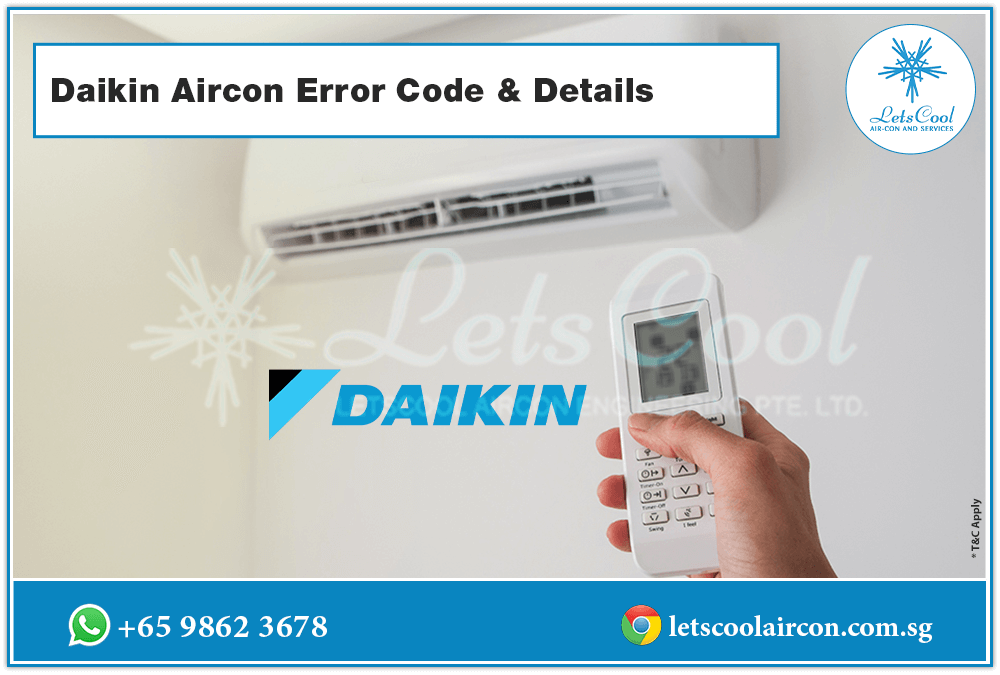Daikin air conditioners are recognized for their efficient performance and reliability. However, like any other appliance, they may sometimes display error codes. These codes signify specific problems and assist users in diagnosing issues swiftly. By understanding these error codes, users can prevent costly repairs and ensure their air conditioners operate at peak efficiency. This guide outlines common Daikin air conditioning error codes and provides effective solutions for fixing them.
What is Daikin aircon Error code
Daikin air conditioners have a system of error codes designed to inform users about any potential malfunctions within the unit. These codes are conveniently displayed either on the air conditioner’s display panel or on the remote control, making it easy for users to access important diagnostic information. Each error code corresponds to a specific problem, allowing you to quickly identify the root cause of the issue. By accurately interpreting the displayed code, you can take informed steps to resolve the problem and ensure your air conditioning system operates smoothly and efficiently.How to Check Daikin Error Codes
How to Check Daikin Aircon Error Codes
Step 1: Use the remote control and press the ‘Cancel’ button continuously until the error code appears on the display.
Step 2: Observe any blinking LED lights on the aircon unit.
Step 3: Refer to the Daikin user manual or this guide for troubleshooting steps.
Get Free Consultation With us
+65 98623678
List of Daikin Aircon Error Code
| Code | Fault Description | Cause/Explanation |
|---|---|---|
| A1 | Micro-computer in PCB is not working | Fault in PCB assembly or external factors like noise. |
| A3 | Drain level is too high | Clogging of dirt in the drain or faulty drain pump. |
| A5 | Overheating or freezing of indoor heat exchanger | Dirty air filter, short circuit, or trouble with the sensor in the heat exchanger. |
| A6 | Fan motor error | Fan motor is locked, overloaded, or has a faulty connection. |
| A7 | Swing flap motor error | Fault with the swing flap motor or faulty connection. |
| AH | Dust collector error | Fault with the dust collector or a dirty element. |
| AJ | Capacity setting error | Faulty capacity or address setting. |
| C3 | Abnormal water level sensor resistance | Disconnected, short-circuited, or faulty water level sensor. |
| C4 | Abnormal resistance level of indoor heat thermistor | Disconnected or short-circuited thermistor. |
| C9 | Resistance of indoor unit suction air thermistor is abnormal | Disconnected cable or short circuit. |
| CE | Abnormal radiation thermistor resistance | Faulty thermistor, disconnected cable, or short circuit of the thermistor. |
| CJ | Abnormal remote controller thermistor resistance | Fault with the built-in remote controller. |
| E0 | Outdoor unit protection devices activated | Clogged refrigerant piping system, insufficient refrigerant, or faulty compressor/fan motor. |
| E3 | High pressure is too high (HPS activation) | Short-circuited/overloaded condenser or dirty heat exchanger. |
| E4 | Low pressure is too low (LPS activation) | Clogged refrigerant piping system, insufficient refrigerant, or faulty LPS switch. |
| E5 | Overheating of compressor (OL activation) | Clogged refrigerant piping system, insufficient refrigerant, or fault with OL or the connection. |
| F3 | Outdoor unit discharge temperature is too high | Insufficient refrigerant, clogged refrigerant piping, or faulty discharge temperature thermistor. |
| H9 | Abnormal resistance of the outdoor air temperature thermistor | Faulty thermistor, disconnected cable, or short-circuited thermistor. |
| J5 | Abnormal resistance of the suction pipe temperature thermistor | Faulty suction pipe thermistor, disconnected cable, or short-circuited thermistor. |
| J6 | Abnormal resistance of the outdoor heat exchanger thermistor | Faulty or short-circuited outdoor heat exchanger thermistor, or disconnected cable. |
| P1 | Open phase power voltage imbalance | Three-phase or open-phase voltage imbalance. |
| U0 | Suction pipe temperature is too high | Fault in refrigerant piping system—clogging, lack of refrigerant, or fault with the expansion valve. |
| U1 | Reverse phase | Three-phase power supply has been reversed. |
| U2 | Open phase or power voltage imbalance | Open-phase or voltage imbalance, power failure, or low DC voltage of the fan motor. |
| U4 | Communication error between indoor and outdoor units/outdoor and BS units | Issue with interconnection wires or PCB fault in indoor/outdoor units. |
| U5 | Communication error between indoor unit and remote controller | Issue with interconnection wires or PCB fault in indoor/outdoor remote controller. |
| UA | Combination error of indoor/BS/outdoor unit, setting error of PCB at site | Incorrect combination of indoor, BS, or outdoor units. |
Preventative Maintenance Tips to Avoid Error Codes
To minimize the risk of encountering error codes, follow these maintenance tips:
- Regularly clean air filters to maintain airflow and efficiency.
- Ensure proper ventilation around the outdoor unit.
- Check for refrigerant leaks periodically.
- Schedule annual aircon servicing with a trusted professional.
Why Choose LetsCool Aircon for Daikin Aircon Repairs?
At Letscool Aircon, we specialize in Daikin aircon servicing and repairs. Our team of certified technicians offers:
- Fast and reliable service in Singapore.
- Transparent pricing with no hidden costs.
- Expert troubleshooting and repair for all Daikin aircon issues.
Conclusion
Familiarizing yourself with Daikin air conditioning error codes is essential for identifying and resolving issues swiftly, preventing them from worsening. Regular maintenance, coupled with timely servicing, plays a crucial role in averting numerous common problems that can disrupt your comfort. Should you face recurring error messages, you can rely on Letscool Aircon for professional repair and maintenance services, ensuring your system operates efficiently and reliably.

